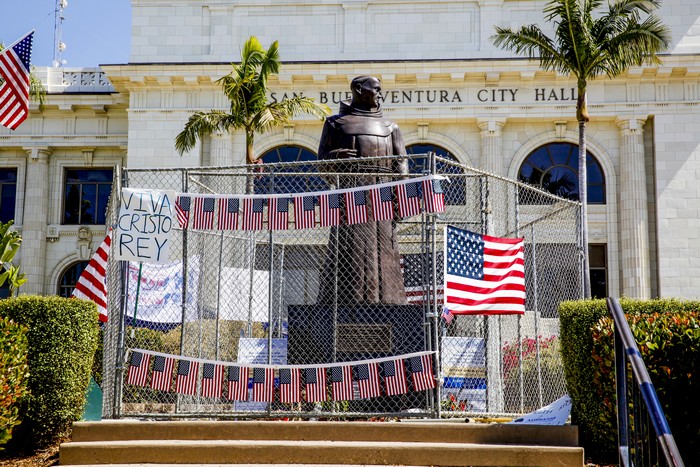by Maria Loveday
I recently received my B.A. degree in art history/art studio from CSUCI. My final capstone project was a research paper analyzing the history, controversy, and vandalism of Junipero Serra and his commemorative statues in California with a focus on the bronze Serra statue in front of Ventura City Hall.
Some interesting research findings include :
Seventy-five years after Serra’s death, 19th c. writers and historians constructed Serra’s civic persona with the goal of masking his Catholic identity which made him more acceptable to non-Catholics as the founder of California.
Both the bronze and wood Serra statues are in violation of the 1st Amendment, just as the Serra Cross was in a 2003 case brought against the city which involved issues of separation of church and state which forced the city to sell the property and cross to a local preservation group.
Recontextualization of controversial monuments and memorials through the commission of counter monuments and interpretive plaques reflecting previously oppressed narratives serve educational purposes.
Serra had a medieval mindset derived from the founding of the Franciscan Order in Assisi, Italy in 1209. Corporal punishment for sins was one of the values upheld by Saint Francis of Assisi and Serra took this to heart as he was known by his fellow friars for being particularly drawn to self flagellation to atone for sins of the flesh. Certainly, scantily clad indigenous Californians would have represented sin to such a pious man as Serra. When natives refused to convert to Catholicism they were flogged if not by Serra, then as a result of his orders. These tactics were hardly respectful of indigenous traditional cultures which had not known corporal punishment.
Contemporary California historians provide ample evidence that the mission system which Serra founded in 1769 laid the foundations for the enslavement and genocide of California’s indigenous peoples regardless of whether Serra intended this outcome or not. The decimation of indigenous cultures in California extends from the 1500’s with the first European explorers to Serra’s mission system to Mexican rule to the Gold Rush and California’s statehood to 2020 Serra statue conflicts. These statues embody oppressive ideologies which have caused generational trauma and continue to cause suffering for indigenous peoples.
It is unfortunate that Ventura has yet to remove their prominent Serra statue, a marker defining its citizenry as supporters of indigenous enslavement and genocide. This is an unpopular position to uphold when historically oppressed peoples are calling for justice through peaceful protests worldwide. The most talked about solution is to remove the statue to San Buenaventura Mission where it would not be recontextualized. If this happens an interpretive plaque needs to replace the statue to explain what happened for the benefit of future generations. An alternate solution might be to replace the statue with one that more accurately reflects Ventura citizens in 2020 and add a plaque about what used to be there. If the Serra statue remained in place the City could fund Chumash artists to sculpt counter monuments and author interpretive plaques for educational purposes balancing the current Eurocentric narrative.
The removal and/or recontextualization of oppressive statues does not lead to the erasure of history, but seeks to reveal histories that have been repressed. Restitution for harms done to indigenous peoples during California’s colonization is long overdue. While it is admirable that citizens, the City Council and the Mayor of Ventura are reevaluating the Serra statue for removal, it remains to be seen whether or not this city and its people are ready to face its’ past and move forward or deny its’ past and remain stuck in illusions which uphold repressive colonialist ideologies.
Serra statue not historic landmark
The Ventura Historic Preservation Committee has decided that the bronze statue of Father Junipero Serra standing in front of City Hall is not a historic landmark. Based upon the fact that it is a replacement of the original statue.
Ventura Community Development Director Peter Gilli stated “It’s important to note for the public that a statue of a historic figure at a prominent location does not automatically make the statue a historic landmark. Also, just the fact that an object is important to the community would not automatically make an object historic.”
The committee voted 4-1 against the statue’s historic status with Vice Chairwoman Ann Huston casting the no vote
CC decisions on statue is scheduled for 6pm
The Ventura City Council on Tuesday night delayed their decision on whether to permanently remove two statues of Father Junipero Serra. One is located in city hall and the other across the street. The delay was due to a technical oversight.
The next meeting on the statue is scheduled for 6pm on Wednesday, July 15. The meeting will be virtual. Go to cityofventura.ca.gov for information on how to watch and participate in the discussion.

